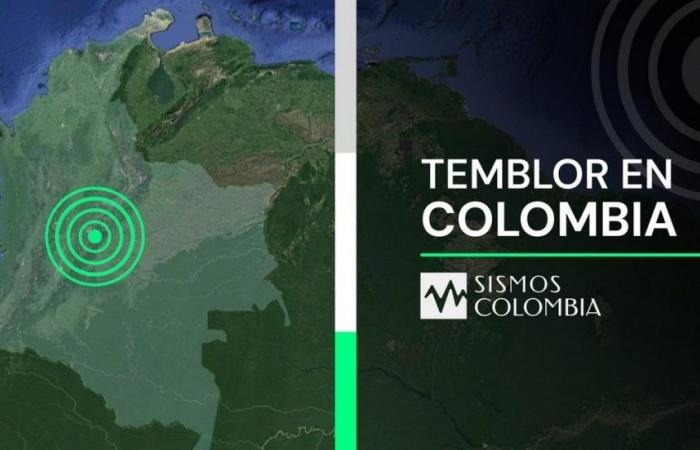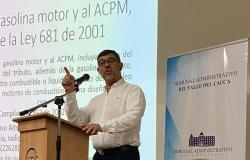News and information about earthquakes in Colombia. We disseminate in real time the seismic activity reports generated by the Colombian Geological Service.
This article was curated by pulse
Jun 26, 2024 – 4:00 am
Visit website
The Colombian Geological Service reports an earthquake of magnitude 3.0 and shallow depth in Toribío, Cauca. The event took place in the area of influence of the Huila Volcano. People are invited to report if they felt it.
For more information: #Tremor
According to the Colombian Geological Service, Colombia is a seismically active country, as there are different tectonic plates that interact with each other (Nazca, South America and the Caribbean) creating a complex geological dynamic, which causes earthquakes to occur in most of the territory.
It is estimated that, on average, 2,500 earthquakes occur per month in the country (approximately 80 per day), but most of them are not perceptible to people. The most seismically active places are the Pacific and Caribbean coasts, and around our mountain ranges.
However, an earthquake can occur at any time, so it is important to be prepared, for people to know the risks they face depending on where they live, as well as what to do in case it shakes.
As the Colombian Geological Service has warned in its official channels, it is not true that it is now shaking more than before; We are simply more aware of the occurrence of earthquakes, because there are currently more resources, tools and information channels to detect and disseminate them.
Why is it important to report an earthquake when we feel it?
Feeling an earthquake depends on several factors, including the magnitude and depth at which it originates, as well as the distance people are from the epicenter. If you feel them, it is key to report their occurrence, as this allows you to quickly estimate the effects of the event that occurred and is crucial so that emergency response agencies can act more effectively.
Every time the Colombian Geological Service reports in its accounting accounts Twitter and Facebook the occurrence of an earthquake, those people who have felt it have the option of filling out Seismo Sentido: the information collection form with which this entity quickly estimates if there was damage, reports it to the entities in charge of responding to that emergency, and determines the intensity of the earthquake (how much it was felt): a key qualitative measure to improve knowledge of the seismic threat in the country.
What are earthquakes?
According to the Colombian Geological Service, earthquakes are shocks that are produced by the release of accumulated energy and that propagate in the form of waves. When these reach the surface, they generate movements that people can perceive and that, according to their level of intensity, can lead to damage to structures and nature (such as cracks and landslides).
They arise due to several causes. The first are the movements of the tectonic plates, which produce deformations and ruptures in which accumulated energy is suddenly released. The second is volcanoes: both the fracturing of rock and the movement of fluids inside the volcano cause volcanic earthquakes. The third is some human activities, such as the extraction of energy resources, the use of water in deep wells, and the injection of fluids into the subsurface.
How are the depth and magnitude of earthquakes calculated?
The magnitude and depth of an earthquake are calculated using data collected through a series of equipment found in monitoring stations located throughout a territory. These record the movements of the ground and, from them, the seismic energy released at the source is calculated, that is, the magnitude.
Although for years the Richter scale was the tool used to determine the size of an earthquake and, from this, measure the energy released at the focus, it is used less and less, due to the emergence of more precise and universal means of measuring them, such as the moment magnitude scale. For this reason, now the magnitude of earthquakes is not measured in degrees. The correct thing is to say: “an earthquake of magnitude 5.0” or the figure assigned to it, but without the complement of the degrees or “on the Richter scale.”
Regarding depth, when an earthquake occurs, different types of waves are generated (P waves, S waves, among others) that are recorded by seismological stations. Each type of wave travels at a specific speed, resulting in different arrival times at the Earth’s surface. These differences in arrival times, mainly between P waves and S waves, allow us to determine the location of the earthquake and, consequently, its depth.
According to the National Unit for Disaster Risk Management -UNGRD- these are the measures and recommendations that should be followed in the event of an earthquake:
What are the recommended precautionary measures before an earthquake?
- Identify safe zones: Know safe places in your home, workplace, or any other place you regularly spend time, such as under solid tables or sturdy desks, in interior door frames, or in open areas away from windows, tall furniture, or bookshelves. .
- Conduct earthquake drills: Regularly practice what to do during an earthquake, including performing “drop, cover, and hold on” (duck, cover your head, and hold on to something solid).
- Secure heavy objects: Secure tall furniture, shelves, pictures, and other heavy objects to prevent them from falling and causing injury during an earthquake.
- Review structural safety: Make sure your home or workplace meets structural safety standards, such as having a solid foundation and reinforcing structures as necessary.
- Have an emergency plan: Develop an emergency plan with your family or co-workers, including meeting points and ways to communicate in case an earthquake hits and phone lines are down.
- Prepare an emergency kit: Have an emergency kit ready with basic supplies such as bottled water, non-perishable food, first aid kit, flashlight, portable radio, batteries, and other essentials.
- Know evacuation procedures: Find out what the evacuation procedures are in your area. Please note escape routes and designated assembly points.
- Educate children: Teach children what to do during an earthquake and practice with them regularly so they know how to react in an emergency.
What should you do during an earthquake to protect yourself?
- Drop, cover and hold on: this is the basic mantra during an earthquake. Crouch under a sturdy table or desk and cover your head and neck with your arms. If there is no solid furniture nearby, cover your head and neck with your hands, and kneel against an interior wall away from windows or tall furniture. Hold on firmly until the shaking has stopped.
- Stay calm: Stay calm and try to control yourself. Avoid panicking and help calm others around you, especially children or people who may be scared.
- Stay away from windows and dangerous objects: Avoid being near windows, glass, mirrors, shelves, tall furniture or any object that could fall and cause injury.
- Don’t run outside: Unless you are right next to a safe exit, don’t try to run outside during an earthquake. Hazards may be outside, such as downed power lines, debris, or damaged buildings.
- Protect yourself from falling objects: If you are in bed, protect yourself by covering yourself with pillows and blankets. If you are in an open outdoor space, stay away from buildings, trees, utility poles, and other objects that could fall.
- Evacuate if necessary: If you are in an unstable building, in an area prone to landslides, or near a coast and there is a risk of tsunami, follow evacuation procedures established by local authorities.
- Maintain communication: If possible, communicate your situation through text messages or other electronic means, but avoid using mobile phones or landlines during the earthquake to avoid congesting networks.
Read all the nation’s news today here.






